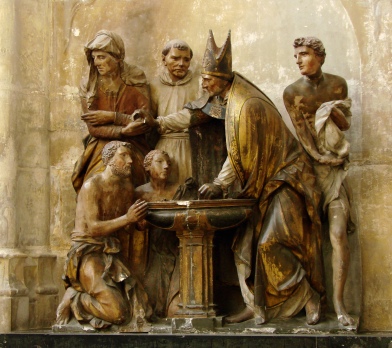A Lenten Reflection
by
Brother Charles
Lent is upon us. It is an ancient tradition, a popular tradition, and a call to action. Let us consider these points one at a time.
An ancient tradition
The observation of a forty-day period of preparation for Easter that shapes the public worship, or liturgy, of the Church dates to the fourth century. Because Lent has the characteristics of fasting and repentance, wholly inappropriate to the joyful celebration of the Lord’s Resurrection, Sundays are not included in Lenten time. Therefore five weeks and five days are needed if we are counting backwards from Easter and omitting every Sunday. That is why Lent begins on a Wednesday. This Wednesday, March 1. The reason that the beginning of Lent is not on this date every year is because Easter is a moveable Feast, calculated every year as the first Sunday after the first full moon following the spring equinox (the Church’s best effort to observe an accurate anniversary of Jesus’ Resurrection).

A popular tradition
Lent is the liturgical response to an ancient popular practice of accompanying friends and loved ones who were preparing for baptism at Easter. Early Christians asked catechumens (those preparing to become Christian) to observe a forty-day period of prayer, fasting, and repentance preceding their submersion into the waters of baptism. The number forty lends itself easily to Christians because of its association with Jesus’ time in the desert as well as the ancient Israelites’ time seeking the Land of Canaan. With the decline of adult baptism in favor of infant baptism, Lent became a time for all Christians to prepare to renew their baptismal vows, a rite that is preserved in the prayers of the Easter liturgy. Signs of new beginnings are observed in nature with approach of spring, in the liturgy, and in the community itself. There is an old monastic custom written into the Rule of St. Benedict (chapter 48) that provides for each monk, at the beginning of Lent, to receive a new book—a precious hand-written tome from the monastic library—for their private consumption throughout the year. An even older custom, still observed, is the reception of ashes, a symbolic reminder of God making us from the clay of the earth and inviting us to prepare for our complete recreation in Christ.
Practicing new beginnings
It is popular custom to give something up for Lent. This is shorthand for the spiritual disciplines of repentance (changing our ways) and renewal. We practice a kind of spiritual athleticism or training for new life. The best way to approach giving something up is to think of it as only half the commitment. What good practice will you put in its place? How will it be an act of love for God, yourself, and others? Maybe you can calculate the money saved from not indulging in some favorite appetite and give it where it might be needed. Maybe you can exchange gossip for deliberately and honestly speaking words that build someone else up. Lent is a focused opportunity to practice the Christian life of love and service. But remember to start the season with Jesus’ admonition against any ostentatious mourning. Whether or not you take ashes Wednesday, start the day with the mindful washing of face. Look in the mirror as you leave for the day and see the joyful face of Christ for others. Here’s looking at you!
photo credit: Wikimedia
Wonderful reflection and so timely.
Brother Bernard
LikeLike
Appreciate these wonderful thoughts as Lent begins. Thank you ! Happy Lent !
LikeLike